This week my colleague Kris (aka WonderYak) and I are talking about D.W. Griffith's
Broken Blossoms (1918) and its interesting and, possibly, progressive portrayal of race.
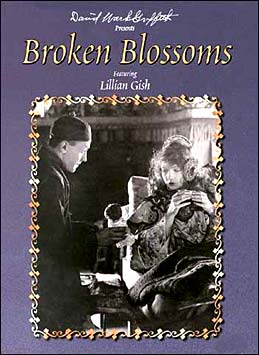
R: I wasn't really sure what to expect before I sat down to watch this movie.
Birth of a Nation is so racist in its portrayal of "savage" African-Americans that prowled the South after the Civil War looking for young white women to corrupt. It really bugs me. However, in
Broken Blossoms, I thought that D.W. Griffith's portrayal of Chinese immigrants was much more sympathetic. Still problematic, but nothing like
Birth... K: I completely agree! In fact, so did many of my students -- almost all who wrote about
Broken Blossoms (their other choice was Chaplin's
Gold Rush) commented on how it felt like Griffith's penance for
Birth... The fact that the villain is a white male, and that almost all white people are portrayed as conniving or cruel or boorish, nearly makes up for the stereotypes that Richard Barthelmess perpetrates as the "Yellow-Faced" Cheng Huan (overly squinted eyes, hunched back, shuffled walk, etc.).
Even Huan's one vice, opium addiction, is portrayed not as something of his own fault, but something forced upon him by Western civilization.
Then there's the fact that the entire narrative is designed to lampoon Western values in general -- "The Orient" is an entirely peaceful, beautiful place in Griffith's recreation; the West is vile and dank. The "chink" comes to spread peace, but even in his earliest attempts (with the "Jackies" at port) he is trampled, both literally and figuratively.
Is Griffith himself trying to claim that he is merely a product of his own broken society?
R: That is an interesting point. D.W. Griffith is from the South and had relatives that fought for the South in the Civil War. Does this excuse his stereotyping of newly-freed African-Americans in
Birth... then? And do you think that he could have made a
Broken Blossoms-esc film with the same amount of cultural empathy based around the story of an African immigrant?
K: This is all speculative, of course, but I feel Griffith could have made any film he wanted, really. His cinematic creativity was only bound by the narratives he chose to film.
We discussed the idea of "excusing" artists in class. The two main questions I posed were, "can one separate an artist from his or her work?" and "does a filmmaker have a responsibility to be socially conscientious?"
I'd personally say "yes" to the former and "no" to the latter. While I deplore the racism that Griffith perpetrated in his work, I can safely say that I admire his skill and respect his additions to cinematic language. I'd also come to his general defense and say that he had a right to express whatever views he wanted. I think I mentioned this to you, but I am thankful that, for instance, The Westboro Baptist Church exists. What they say makes me want to vomit; but if they weren't allowed to say it, how long would it be before I weren't allowed to say what I felt?
"Does a filmmaker have a responsibility to be socially conscientious?"
A discussion cropped up today w/r/t Buster Keaton's
The General. One student was terribly offended by the fact that Keaton used the Civil War as a backdrop for what is essentially a slapstick comedy. "Why," he argued, "use such a terrible event in our history as a playground for antics?" I rebutted that it is because of the shared history, the almost culturally universal understanding of events like War, that they are ripe fodder for art: there is no need for a backstory. It's just there. And then, with Comedy, you get the wonderful underline of tragedy. As love stories are best told against the specter of death, great Comedy is best told in the shallow waters of tragedy.
The same goes for Tarantino's
Inglorious Basterds -- yes, he makes light of WWII, but it's only because he used WWII that the film functions. Or Benigni's
Life is Beautiful, another film that came up today, with equally contentious debate.
Did Keaton or Tarantino or Benigni act irresponsibly?
Filmmakers, and artists in general, only have a few responsibilities (if one can call them that): to entertain (in the classical, escapist definition of the word); to push boundaries; and/or to inform.
And by push boundaries, I don't mean be purposefully offensive...I just mean try to create something new (or, more specifically, tell us something in a new way). Make it funnier, or more exciting, or sexier, or more scintillating, or more pornographic, or more violent, or emotional, or beautiful, etc., than the last work.
And by entertain, I really just mean create a world the audience can escape to. It might be terribly unpleasant (ala
Mysterious Skin) or wondrous (ala
Avatar), as long as it's compelling.
So, long midnight ramble made short, Griffith does all of those three things with
Birth... therefore, can he really be blamed for the work he created? Does he need to be excused?
And he also did those three things in
Broken Blossoms, but with the added bonus of being significantly less offensive (though not entirely).
R: I agree and disagree. I don't believe that artists should censor themselves, but I do believe that they should be conscious of the art that they produce and its impact on society. For instance, if we take
Birth of Nation, D.W. Griffith may have just wanted to show a sympathetic portrayal of what happened in the South after the Civil War because he had family that lived through that time and it was, by all accounts, a very difficult period in American history. However, his valorous portrayal of the Ku Klux Klan at that point in history inspired the actual Klan in the 1910s to use the film as a recruitment tool. They used the film to sway new members up until the 1990s by some accounts. His intentions for
Birth... may have been very different from the impact that it had on the public, but its impact was widespread and devastating to African-Americans in this country. The film inspired people to commit heinous hate crimes in the name of racial purity.
The other thing that we do in Cultural Studies is look for systematic representations. It is interesting that your student brought up how the backdrop of
The General is the South during the Civil War. While there were two sides fighting during the actual war we don't have a lot of filmic representations of the North, but we have a fair amount of the South, epic films at that:
Cold Mountain,
Gone With the Wind,
Raintree County, etc. In fact, going from memory I couldn't think of any film that was from the perspective of the North, but then was reminded that
Glory was about the first African-American unit in combat. So if we think about how much we want to empathize with the South in film there is something there that says a lot about our culture and what we value. If you compare this to films about World War II you do not have empathetic portrayals of the Nazi's, unless, like in
Valkyre, they are trying to kill Hitler.
On the other hand, if we look at
Broken Blossoms and its portrayal of a completely high "Yellow Man", it is harder for me to think of other celluloid characters that are Chinese drug addicts. Now if he magically knew some sort of martial arts then he might fit into a cliched representation that is actively working to warp the popular consciousness of the film-going public. Singularly, "bad" representations of people are not harmful. It is when they are systematic that you have this cultural absorption of grains of "truth" from their repetition. And this isn't on a conscious level. I could go on and on about this, but if interested readers might want to check out my posts on "The Cinematic Other: Dominatrix" and "'Avatar' and How White Men Are the Best at Everything".
The one thing that is systematic about his character is that he is actually a white actor in "Yellowface". This is systematic: Katherine Hepburn did it in
Dragon Seed (1944) and Mickey Rooney did it (horribly) in
Breakfast at Tiffany's (1961) amongst others. This also fits into the idea that White Men (and women) Are the Best at Everything, even playing cultural minorities. There is a really great article about this on
Racebending.com.
Since there is no way we could ever wrap up this conversation I figured that we might put on our teacher hats and maybe list what questions we would pose to students regarding
Broken Blossoms, race, and the social responsibility of artists/filmmakers:
• Do filmmakers/artists have a responsibility to make socially conscious work?
• Can you separate the intent of a film/filmmaker versus the impact of that film on society?
• Can you separate an artist's personal ideology/life from his or her work? (Think Roman Polanski.)
• Is it ever appropriate to use Yellowface/Blackface in a film?
* Is there a "caste" system in film? Meaning do darker colored minorities get treated worse than their lighter-skinned peers?
Other Resources:
•
Slaying the Dragon. Dir: Deborah Gee. 1988.
•
"Yellowface: A Story in Pictures" from Racebending.com
 She represented many of the things that I feared as a child - old people, ugly women, long fingernails, warts, disfigurement, and aliens (who are also green). And that is exactly what the cinematic other is supposed to be. The cinematic other is a concept by which we inscribe our cultural fears onto the evil or othered characters in film. These attributes shift with time, but are always from a white, heterosexual, middle-class/upper-class, male position since they are the ones who control American (and global) media. Thus, women, children, homosexuals, foriegners, old people, immigrants, people of color, etc. etc. are generally cast as the "other" or villain in Hollywood films.
She represented many of the things that I feared as a child - old people, ugly women, long fingernails, warts, disfigurement, and aliens (who are also green). And that is exactly what the cinematic other is supposed to be. The cinematic other is a concept by which we inscribe our cultural fears onto the evil or othered characters in film. These attributes shift with time, but are always from a white, heterosexual, middle-class/upper-class, male position since they are the ones who control American (and global) media. Thus, women, children, homosexuals, foriegners, old people, immigrants, people of color, etc. etc. are generally cast as the "other" or villain in Hollywood films.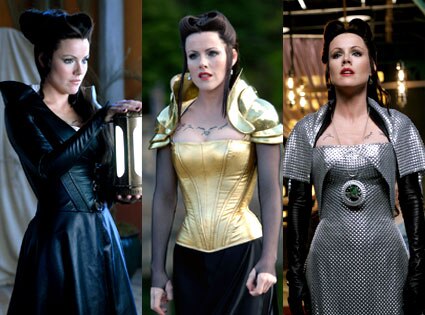 Yep. She's been dominatrixed up for the 21st century. Indeed, even E's Kristen Dos Santos picked up on it in her write-up "Tin Man: Welcome to the O.Z., Bitch!" (C'mon Kristen, do you have to use the B-word?):
Yep. She's been dominatrixed up for the 21st century. Indeed, even E's Kristen Dos Santos picked up on it in her write-up "Tin Man: Welcome to the O.Z., Bitch!" (C'mon Kristen, do you have to use the B-word?): Then there is the Disney version of the dominatrix from Enchanted.
Now while I can watch Tin Man as an adult and roll my eyes every time I see Kathleen Robertston strapped into another corset, Enchanted was made by Disney for a youthful audience who probably have not studied how film reflects, but more importantly, influences our culture. Thus, they begin to absorb the message that sexual deviance (meaning anything but missionary, monogamous sex with your husband or wife) is evil. Undoubtedly, children's films are usually the most evil when it comes to how they code their villains with all the attributes that are culturally unacceptable to the conservative white men who dominate film production. I will go into this in more in another post since there is so much more to be discussed, but in the meantime think about all the Disney villains you've ever seen and who they culturally represent. Crazy, isn't it.
Then there is the Disney version of the dominatrix from Enchanted.
Now while I can watch Tin Man as an adult and roll my eyes every time I see Kathleen Robertston strapped into another corset, Enchanted was made by Disney for a youthful audience who probably have not studied how film reflects, but more importantly, influences our culture. Thus, they begin to absorb the message that sexual deviance (meaning anything but missionary, monogamous sex with your husband or wife) is evil. Undoubtedly, children's films are usually the most evil when it comes to how they code their villains with all the attributes that are culturally unacceptable to the conservative white men who dominate film production. I will go into this in more in another post since there is so much more to be discussed, but in the meantime think about all the Disney villains you've ever seen and who they culturally represent. Crazy, isn't it.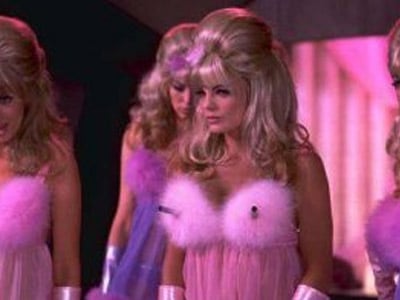



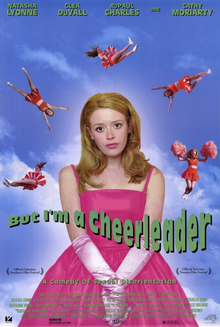

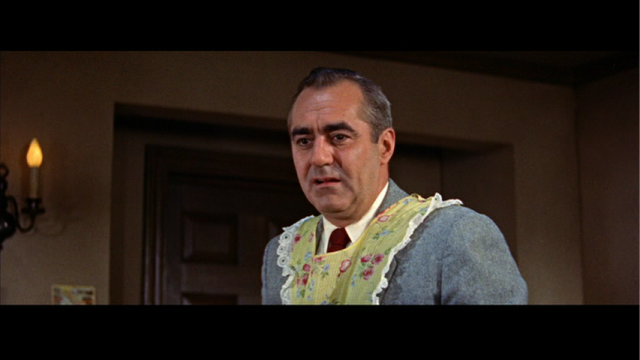

 Although I have seen the film many times, the one thing that struck me this time around was how much the role of the editor was feminized. Especially in contrast to the very masculine role of the director. In fact, the way that many of the directors in the film spoke about their editors, it was as if they were a married couple; the director was the husband and head of household and the editor was the wife who supported the husbands' endeavors. Truth be told, as a filmmaker myself, I completely realize that the relationship between and editor and a director is intense and intricate. However, the issue was not the closeness of the relationship between editor and director, but rather the insistence by several prominent directors that women make better editors due to an inherent "maternal" quality that they/we possess.
Although I have seen the film many times, the one thing that struck me this time around was how much the role of the editor was feminized. Especially in contrast to the very masculine role of the director. In fact, the way that many of the directors in the film spoke about their editors, it was as if they were a married couple; the director was the husband and head of household and the editor was the wife who supported the husbands' endeavors. Truth be told, as a filmmaker myself, I completely realize that the relationship between and editor and a director is intense and intricate. However, the issue was not the closeness of the relationship between editor and director, but rather the insistence by several prominent directors that women make better editors due to an inherent "maternal" quality that they/we possess.